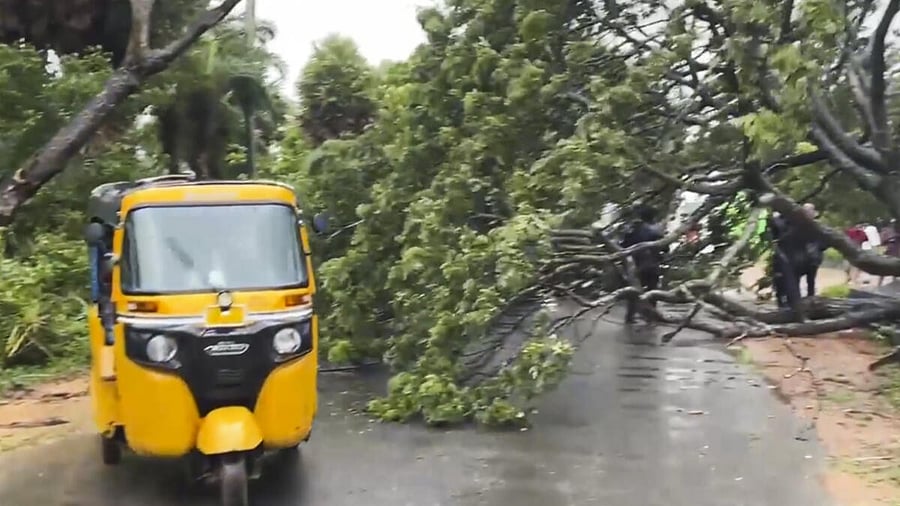
A fallen tree blocks a road as Cyclone Montha lashes the city with heavy rain and 50-60 km/hr winds, in Machilipatnam, Andhra Pradesh, Tuesday, Oct. 28, 2025.
Credit: PTI Photo
Hyderabad: Cyclone Montha, which intensified into a severe cyclonic storm by Tuesday morning, pounded coastal Andhra Pradesh with torrential rains, powerful winds, and flooding, particularly between Machilipatnam and Kakinada, where it made landfall on Tuesday night.
According to the IMD, the landfall process was expected to last four to five hours. The cyclone was packing winds of 90–100 kmph, gusting up to 110 kmph.
Latest observations by IMD indicated that the landfall process continues as it will continue to move north-northwestwards and cross Andhra Pradesh coast between Machilipatnam and Kalingapatnam around Kakinada during next 3-4 hours as a severe cyclonic storm with a maximum sustained wind speed of 90-100 kmph gusting to 110 kmph.
Since morning, heavy to very heavy rainfall has lashed Kakinada, Machilipatnam, Krishna, West Godavari, Konaseema, Bapatla, Prakasam, Nellore, and parts of Rayalaseema. As Montha made landfall, sea waves surged along several stretches of the coast between Machilipatnam and Kakinada.
An eight-kilometre stretch of the beach road between Kakinada and Uppada has suffered significant damage, while several other roads remain inundated, disrupting vehicular movement. The Andhra Pradesh government has launched extensive rescue and relief operations, evacuating residents from cyclone-prone villages to relief camps equipped with food and water supplies.
Under the influence of the cyclone, isolated extremely heavy rainfall is expected over Coastal Andhra Pradesh, Rayalaseema, and Telangana through Tuesday and Wednesday.
Authorities have ordered all commercial establishments and shops to close by 7 pm, urging residents to stay indoors unless in emergencies. Several trees were uprooted, and power supply was suspended in many places as a precautionary measure.
Chief Minister N Chandrababu Naidu directed officials to deploy drones to monitor inundated areas continuously. He emphasized the need to focus on regions prone to flash floods due to overflowing streams. Naidu, along with Deputy Chief Minister Pawan Kalyan, reviewed the cyclone situation at the Secretariat. He instructed officials to mobilise rescue and relief machinery according to field needs and to gather real-time information from village secretariats for effective relief measures.
The Chief Minister also directed special monitoring of low-lying areas in West Godavari, warning of possible floods from the Yerra Kaluva stream due to incessant rains over the past two days.
Officials reported that cyclone alerts were sent to the mobile phones of 1.92 crore people. They said essential commodities have been stocked, and 2,703 generators kept ready. Police wireless systems were fully operational with 81 towers to ensure communication in emergencies. Crops spread over 43,000 acres in Konaseema, Prakasam, Nandyala, Kadapa, and East Godavari districts were reported submerged. Naidu instructed that a digital system be set up to help farmers upload information about crop damage for relief assessment.
As a precaution, flight services to and from Visakhapatnam and Vijayawada airports were suspended on Tuesday. Flight operations will resume on Wednesday depending on weather conditions. Visakhapatnam Airport Director N Purushottam said nearly 30–32 domestic and international flights were cancelled, while around 16 flights were cancelled at Vijayawada airport.
In the Waltair Division of the East Coast Railway, Divisional Railway Manager Lalit Bohra said help desks have been set up at 10 major stations to provide real-time updates on train cancellations, diversions, and short-terminations. More than 23 trains have been cancelled and 15 rescheduled to ensure passenger safety.
To mitigate disruptions, 17 diesel locomotives and generators have been placed on standby for quick restoration in case of power failure. Expert teams stationed every 50 kilometres stand ready to respond to emergencies, and adequate drinking water facilities have been arranged in railway colonies and stations.
Communication systems have been strengthened with satellite phones and enhanced rail network connectivity to maintain coordination. A 24x7 war room has been activated at the divisional headquarters to monitor developments and coordinate field operations.
Accident relief trains, material relief trains, excavators, and bulldozers have been strategically deployed across key routes including Kottavalasa–Kirandul, Koraput–Rayagada, Rayagada–Vizianagaram, and the Duvvada–Visakhapatnam–Palasa section for immediate restoration of train services post-cyclone.